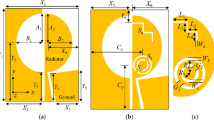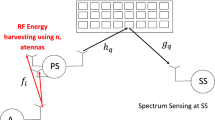Abstract
In order to protect the primary user from being interfered, most of the related works focus only on the restriction of the missed detection probability, which may cause over-protection of the primary user. Thus the interference probability is defined and the interference-aware sensing model is introduced in this paper. The interference-aware sensing model takes the spatial conditions into consideration, and can further improve the network performance with a good spectrum reuse opportunity. Meanwhile, although the detection performance can be further improved by the cooperative spectrum sensing, it also introduces additional reporting time corresponding to the number of cooperative users (CUs), which may decrease the throughput of the CRN. Motivated by the above, in this paper, we study the throughput tradeoff for interference-aware cognitive radio networks. For cooperative spectrum sensing, the Logic-OR fusion rule is used. By jointly optimizing the sensing time and the number of the CUs, the maximum throughput can be achieved. Theoretical analysis is given to prove the feasibility of the optimization and numerical simulations also show that the maximum throughput can be achieved when the sensing time and the number of the CUs are both optimized.





Similar content being viewed by others
References
Haykin, S. (2005). Cognitive radio: Brain-empowered wireless communications. IEEE Journal on Selected Areas in Communications, 23(2), 201–220.
Akyildiz, I. F., Mehmet, W.-Y. L., Vuran, C., et al. (2006). NeXt generation/dynamic spectrum access/cognitive radio wireless networks: A survey. ELSEVIER Computer Networks, 50, 2127–2159.
Xu, Y., Shen, A., Shen, L., Wu, Q., et al. (2013). Decision-theoretic opportunistic spectrum access: Strategies, challenges and solutions. IEEE Communication Survey & Tutorial, 15, 1689–1713.
Xu, Y., Wang, J., Wu, Q., et al. (2012). Optimal energy-efficient channel exploration for opportunistic spectrum usage. IEEE Wireless Communications Letters, 1(2), 77–80.
Xu, Y., Wang, J., Wu, Q., et al. (2012). Opportunistic spectrum access in cognitive radio networks: Global optimization using local interaction games. IEEE Journal of Selected Topics in Signal Processing, 6(2), 180–194.
Tandra, R., Sahai, A., & Mishra, S. M. (2009). What is a spectrum hole and what does it take to recognize one. Proceedings of IEEE, 97(5), 824–848.
Wu, Q., Ding, G., Wang, J., et al. (2013). Spatial-temporal opportunity detection in spectrum-heterogeneous cognitive radio networks: Two-dimensional sensing. IEEE Transactions on Wireless Communications, 12(2), 516–526.
Yucek, T., & Arslan, H. (2009). A survey of spectrum sensing algorithms for cognitive radio applications. IEEE Communications Surveys and Tutorials, 11(1), 116–130.
Zeng, Y., Liang, Y.-C., Hoang, A. T., et al. (2010). A review on spectrum sensing for cognitive radio: Challenges and solutions. EURASIP Journal on Advances in Signal Processing, 2010, 1–16.
Quan, Z., Cui, S., & Sayed, A. H. (2010). Optimal linear cooperation for spectrum sensing in cognitive radio networks. IEEE Journal of Selected Topics in Signal Processing, 2(1), 28–40.
Ma, J., Zhao, G., & Li, Y. (2008). Soft combination and detection for cooperative spectrum sensing in cognitive radio networks. IEEE Transactions on Wireless Communications, 7(11), 4502–4507.
Sayed, A. H., Cui, S., & Quan, Z. (2008). Optimal linear cooperation for spectrum sensing in cognitive radio networks. IEEE Journal of Selected Topics in Signal Processing, 2(1), 28–40.
Maleki, S., Chepuri, S. P., & Leus, G. (2011). Energy and throughput efficient strategies for cooperative spectrum sensing in cognitive radios. In IEEE international workshop on signal processing advances in wireless communications (pp. 71–75).
Huogen, Y., Wanbin, T., & Shaoqian, L. (2011). Optimization of cooperative spectrum sensing in multiple-channel cognitive radio networks. In IEEE GLOBECOM.
Fan, R. F., & Jiang, H. (2010). Optimal multi-channel cooperative sensing incognitive radio networks. IEEE Transactions on Wireless Communications, 9(3), 1128–1138.
Zhang, T., Wu, Y., Lang, K., et al. (2010). Optimal scheduling of cooperative spectrum sensing in cognitive radio networks. IEEE Systems Journal, 4(4), 535–549.
Zhang, W., Mallik, R. K., & Letaief, K. B. (2009). Optimization of cooperative spectrum sensing with energy detection in cognitive radio networks. IEEE Transactions on Wireless Communications, 8(12), 5761–5766.
Peh, E., Liang, Y.-C., Guan, Y. L., et al. (2009). Optimization of cooperative sensing in cognitive radio networks: A sensing-throughput tradeoff view. IEEE Transactions on Vehicular Technology, 58(9), 5294–5299.
Liang, Y., Zeng, Y., Peh, E. C. Y., et al. (2008). Sensing-throughput tradeoff for cognitive radio networks. IEEE Transactions on Wireless Communications, 7(4), 1326–1337.
Lin, Y., Liu, K., & Hsieh, H. (2013). On using interference-aware spectrum sensing for dynamic spectrum access in cognitive radio networks. IEEE Transactions on Mobile Computing, 12(3), 461–474.
Acknowledgments
This work was supported by the National Science Foundation of China under Grant Nos. 61172062 and 61301160, and in part by Jiangsu Province Natural Science Foundation of China under Grant No. BK2011116.
Author information
Authors and Affiliations
Corresponding author
Rights and permissions
About this article
Cite this article
Song, F., Kan, C., Wu, Q. et al. Optimal Cooperative Spectrum Sensing in Interference-Aware Cognitive Radio Networks. Wireless Pers Commun 82, 2171–2184 (2015). https://doi.org/10.1007/s11277-015-2340-3
Published:
Issue Date:
DOI: https://doi.org/10.1007/s11277-015-2340-3




